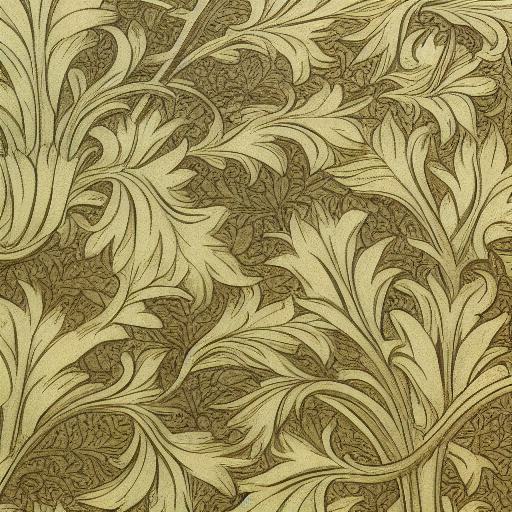How to express our idea with prompt?
In the field of artificial intelligence, prompts are commonly used to generate images based on specific themes or concepts. A prompt is a set of instructions or guidelines given to an AI model that it uses to create an image. Learn more with the example of prompt generating the image above ” a close up of a pattern of flowers, a mid-nineteenth century engraving by William Morris, arts and crafts movement, acanthus, acanthus scroll, art nouveau, elegant“.
Firstly, the prompt specifies that the image should be a close-up of a pattern of flowers. This sets the overall subject matter of the image and provides a clear focus. It also suggests that the image will be highly detailed, with intricate and delicate features.
The next element of the prompt is the reference to William Morris, a key figure in the arts and crafts movement. This movement emphasized the importance of traditional craftsmanship and rejected the mass-produced goods of the Industrial Revolution. The inclusion of this reference suggests that the image should have a handcrafted feel and be rooted in traditional design.
The prompt also references the acanthus plant and acanthus scroll, which are common motifs in art nouveau. These elements suggest that the image should have a flowing, organic feel and feature natural forms.
Finally, the prompt includes the word “elegant,” which suggests that the image should have a sophisticated, refined quality. This could manifest in the use of a muted color palette or the incorporation of fine details and textures.
William Morris
William Morris was a British artist, designer, writer, and socialist who was active during the Victorian era. He is known for his significant contributions to the Arts and Crafts Movement, which aimed to revive traditional handicrafts and combat the industrialization of mass production.
One of Morris’s most famous works is the wallpaper design “Willow Boughs,” which he created in 1887. This pattern features delicate willow branches and leaves in a repeating pattern, reflecting Morris’s love of nature and the natural world. The design is considered a quintessential example of Morris’s decorative style, which is characterized by intricate patterns, rich colors, and a focus on craftsmanship.
Morris was also known for his social activism and commitment to socialism, which he saw as a means to create a more just and equitable society. He believed that art and design had the power to uplift and transform people’s lives, and he saw his work as part of a larger movement to create a more beautiful and harmonious world. Today, Morris’s legacy lives on through his many designs, writings, and his ongoing influence on the decorative arts.
Acanthus Plant and Acanthus Scroll
The acanthus plant and acanthus scroll are common motifs used in Art Nouveau. The acanthus plant is a leafy plant with deep lobes and sharp points. It was used in ancient Greek and Roman architecture and has since been incorporated into decorative art. In Art Nouveau, the acanthus plant was often stylized and used in a variety of ways, such as in the curves of furniture or the details of architecture.
The acanthus scroll is a design element that evolved from the acanthus plant. It is a twisting and curling shape that resembles the curling leaves of the plant. It was often used in the borders of decorative art, such as in the margins of illuminated manuscripts or the edges of tapestries. In Art Nouveau, the acanthus scroll was used in a more fluid and organic way, often incorporated into the flowing lines of furniture or architectural details.
When creating shapes or designs with no specific rules or limitations, such as the acanthus plants, AI relies on deep learning algorithms that have been trained on a large dataset of similar images or designs. Through this training, the algorithm can identify common patterns and features that are often found in these types of designs, and use that knowledge to generate new designs or shapes that follow the same aesthetic style. The result is an AI-generated design that is unique, but still fits within the parameters of the original prompt.
Decorate your design with AI Generated Images
AI can assist us in generating stunning patterns and graphics, which can be used to adorn and enhance the visual appeal of our designs. Add them into design tools like Visual Paradigm Online, create and share of your work with others.


